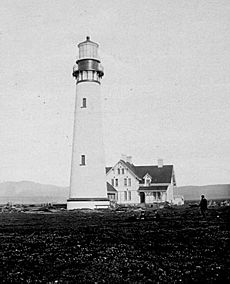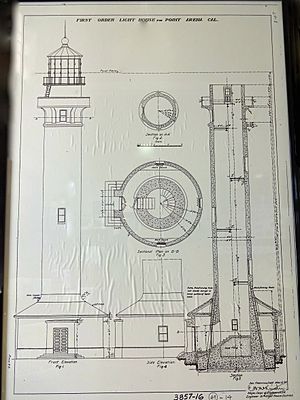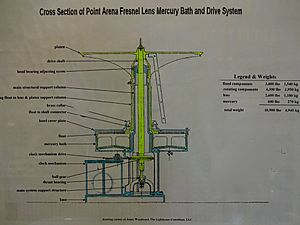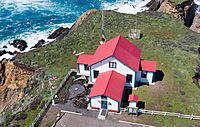Point Arena Light facts for kids
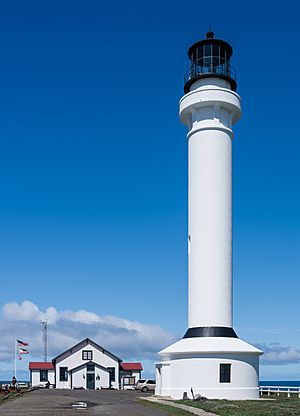 |
|
| Point Arena Light | |
|
|
|
| Location | Two miles north of Point Arena California United States |
|---|---|
| Coordinates | 38°57′17.1″N 123°44′25.8″W / 38.954750°N 123.740500°W |
| Year first constructed | 1870 (first) |
| Year first lit | 1908 (current) |
| Automated | 1977 |
| Foundation | concrete |
| Construction | reinforced concrete |
| Tower shape | cylindrical tower with balcony and lantern |
| Markings / pattern | white tower, black lantern |
| Height | 115 feet (35 m) |
| Focal height | 155 feet (47 m) |
| Original lens | First order rotating Fresnel lens mercury floated |
| Current lens | DCB-224 |
| Range | 25 nautical miles (46 km; 29 mi) |
| Characteristic | Fl W 15s. |
| Admiralty number | G4358 |
| ARLHS number | USA-611 |
| USCG number | 6-0420 |
The Point Arena Light is a famous lighthouse located in Mendocino County, California, California, United States. It stands about two miles (3 km) north of the town of Point Arena, California. This lighthouse is around 130 miles (210 km) north of San Francisco.
Today, the lighthouse has a small museum and a gift shop. You can take guided tours of the light station. You can also explore the grounds on your own.
Contents
Where is Point Arena Light?
The first European to see Point Arena was Bartolomé Ferrer in 1543. He was a Spanish explorer. He called it Cabo de Fortunas, which means "cape of fortunes" in Spanish. Later, in 1775, a Spanish lieutenant named Juan Francisco de la Bodega y Quadra renamed it Punta Delgado, meaning "narrow point."
Eventually, the area became known as Point Arena. This name means "sand point." Point Arena is a thin piece of land that sticks out about half a mile (800 m) into the Pacific Ocean. This sandy point is dangerous for ships. That's why a lighthouse and a fog signal were needed here.
The First Lighthouse Structure
The first lighthouse at this spot was built in 1870. It was made of brick and mortar. The tower had fancy iron supports for its balcony. There was also a large home for the lighthouse keeper. This home was big enough for several families to live in.
However, in April 1906, a huge earthquake hit the light station. The earthquake badly damaged both the keeper's home and the lighthouse. They were so broken that they had to be torn down.
Building a Stronger Lighthouse
After the earthquake, the United States Lighthouse Board hired a company from San Francisco. Their job was to build a new lighthouse. The board made sure the new lighthouse would be strong enough to survive future earthquakes.
The company chosen usually built factory smokestacks. This is why the new Point Arena Lighthouse looks the way it does. It was built with steel rods inside concrete. This made it very strong. It was the first lighthouse ever built using this method.
The new lighthouse started working in 1908. This was about 18 months after the earthquake. It stands 115 feet (35 m) tall. It had a huge 1st Order Fresnel lens. This lens was more than six feet wide and weighed over six tons.
The Amazing Fresnel Lens
The Fresnel lens was made of 666 hand-ground glass prisms. All these prisms focused light towards three sets of double "bullseyes." These bullseyes gave the Point Arena Lighthouse its special "light signature." It would flash twice every six seconds.
This amazing lens was worth over $3.5 million. It was set in a solid brass frame. The lens was built in France.
How the Light Worked
Before electricity, the giant lens was turned by a clockwork machine. The lighthouse keepers, also called "wickies," had to hand-crank a 160-pound weight up the center of the lighthouse. They had to do this every 75 minutes to keep the lens spinning.
The light itself came from a "Funck" hydraulic oil lamp. This lamp needed to be refueled every four hours. The wicks also had to be trimmed often. Later, two powerful 1,000 watt electric lamps were put in. A small 1⁄8 horsepower electric motor replaced the old clockwork system.
Modern Changes to the Lighthouse
In 1978, the old fog signal at the station was turned off. A bell buoy was placed nearby instead. In June 1977, an automatic aircraft-type beacon was installed on the balcony. This meant the historic 1st Order Fresnel Lens was no longer used.
At that time, the Fresnel lens was the only mercury-floated light still working in its area. The new aircraft beacon weighed 400 pounds. It was later replaced by a lighter, 40-pound modern rotating light. This new light still uses the ideas of the Fresnel lens to shine light far away.
Keeping the Light On
The lighthouse has a battery-powered emergency system. This system acts as a backup if the power goes out. There is also a radio beacon that sends a signal 50-mile (80 km) from the station. This helps sailors find their way.
The first oil lamp could be seen for about 18 miles (29 km). The large 1st Order Fresnel Lens could be seen for 20 miles (32 km). The modern rotating light used today can be seen for 16 miles (26 km).
Point Arena Light Today
In 1984, a group called the Point Arena Lighthouse Keepers took over the light station. They are a nonprofit organization. They leased the land from the Coast Guard and the Department of Transportation for 25 years.
In November 2000, this nonprofit group officially became the owners of the property. They earned this because they worked hard to preserve the historic site and offer educational programs. They get money from daily visitors, gift store sales, memberships, and renting out the old Keeper's homes as vacation houses. This money helps them continue their preservation work, upgrade the facilities, and offer educational activities.
The Point Arena Light is also recognized as California Historical Landmark No. 1035.
Fun Facts About the Lighthouse
The final scenes of the movie Forever Young (1992), starring Mel Gibson, were filmed near the lighthouse. The lighthouse also appears in the 2014 movie Need for Speed. In that movie, it's the finish line for an underground supercar race. This race is the exciting end of the film.
Protecting Ocean Life
The Point Arena State Marine Reserve & Point Arena State Marine Conservation Area are two special ocean areas. They are called marine protected areas. They stretch out from Point Arena into the ocean. Other similar areas nearby include Sea Lion Cove State Marine Conservation Area and Saunders Reef State Marine Conservation Area. These areas are like underwater parks. They help protect ocean wildlife and the natural ocean environments.
Images for kids



